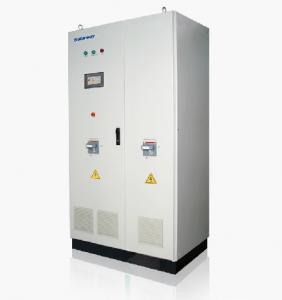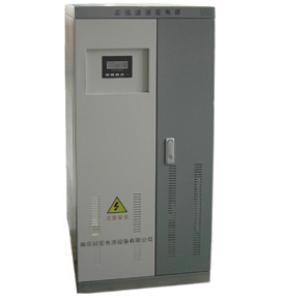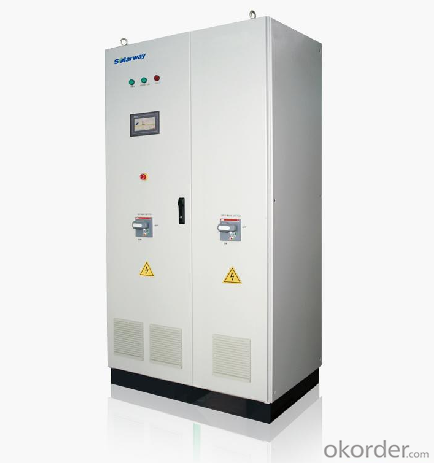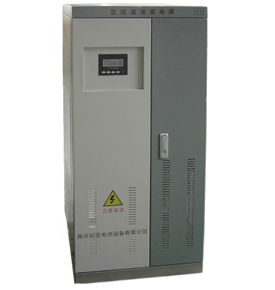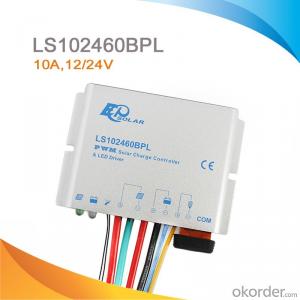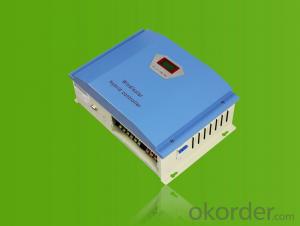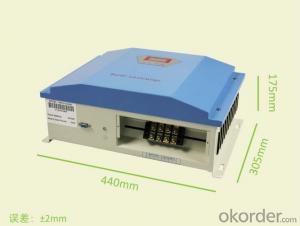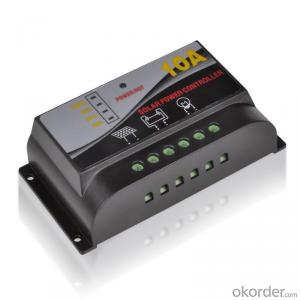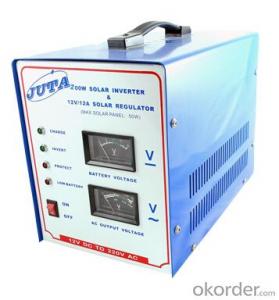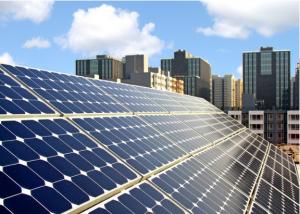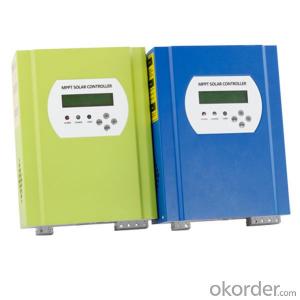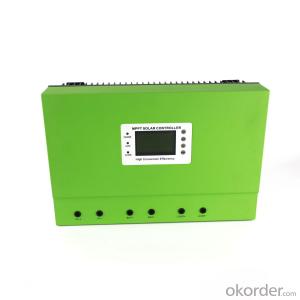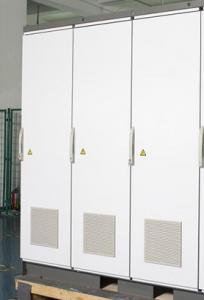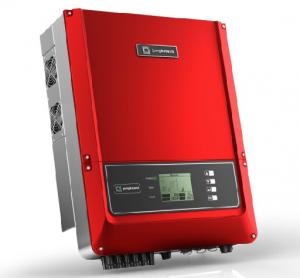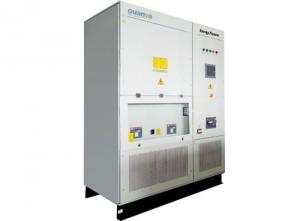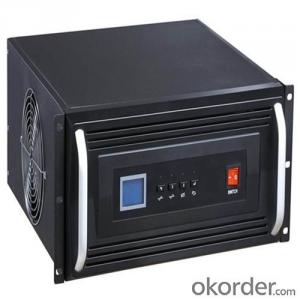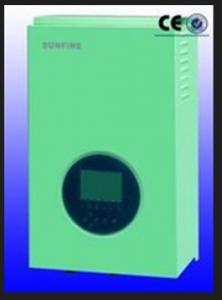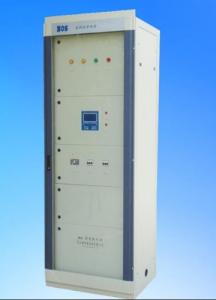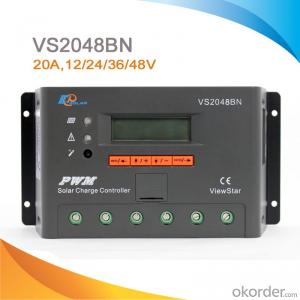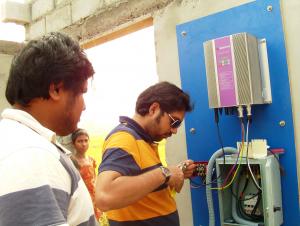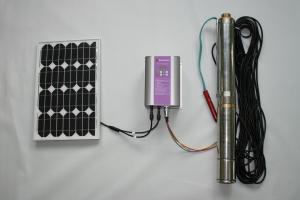PV Off-Grid Inverter GN-10/20/30/40/50KF Switch Box for Solar Controllers from CNBM
- Loading Port:
- China Main Port
- Payment Terms:
- TT or LC
- Min Order Qty:
- -
- Supply Capability:
- -
OKorder Service Pledge
OKorder Financial Service
You Might Also Like
Description:
CNBMSOLAR is a world-leading and Vertical integrated manufacturer of high-performance with Silicon,
Wafer, Cells, Modules, which convert sunlight into electricity for residential, commercial, and utility-scale
power generation.
The capacity of CNBMSOLAR is reach to 1GW, and make sure each year our shipment capacity is more
Than 700-800MWs, at the same time, we have set up the largest solar power station with our partner
in Ukraine.
CNBM is a Quality + Service oriented company with“Excellence at Each Step” approach, composed of
the finest components from TUV and IEC-certified partners around the world, CNBM modules consistently
undergo a variety of trials at the company’s Test & Development Centre, ensuring peak performance
capabilities. The company is committed to develop and provide the world with clean and renewable energy
to ease the energy shortages as well as human kind’s impact on the environment.
Data:
Rated Capacity(Kva) | 1(KVA) | 3(KVA) | 5 (KVA) | ||
Dc Input | Rated Voltage(Vdc) | 48.0(VDC) | 48.0(VDC) | ||
Low Voltage(VDC) | 43.2(VDC) | 43.2(VDC) | |||
Low Voltage Resume (VDC) | 50.4(VDC) | 50.4(VDC) | |||
Load Overvoltage(VDC) | 60.0(VDC) | 70.0(VDC) | |||
Load Overvoltage Resume(VDC) | 58(VDC) | 66(VDC) | |||
Grid Input | Input Voltage Range | ---------- | 220±15﹪ (VAC) | ||
Input Frequency | ---------- | 50±1(Hz) | |||
Switching Mode | ---------- | 00、21、22 | |||
Switching Time | ---------- | ≤10(ms) | |||
Ac Output | Output Waveform | sine wave | sine wave | ||
Overload Ability | ---------- | 120% 1min | |||
Output Voltage | ---------- | 220±3%(AC) | |||
Output Frequency | ---------- | 50±0.04(Hz) | |||
THD | ---------- | ≤3℅ (THD) | |||
Dynamic Response(0~100%) | ---------- | 5% | |||
Inverter Efficiency | ≥85% | ≥80% | |||
Crest Coefficient(CF) | 3:1(CF) | 3:1(CF) | |||
Continuous Running Time | Continuous running | ||||
Display | LCD | LCD | |||
Content | ---------- | DCvoltage, dc current, voltage, utility line frequency, output voltage, output current, output frequency, output power | |||
Communication Interface | no | RS232 | |||
Lightning Protection Device | no | ||||
Protection | Overcharge, Overdischarge, Overload, Short Circuit, Reverse Polarity, Internal Overheated Protections,Etc | ||||
Reference Dimensions(D\W\H Mm) | 380*340*143 | 500*483*267 | 550*480*800 | ||
Reference Weight(Kg) | 32 | 68 | 128 | ||
Protection Class | IP20 | ||||
Environment | Noisy(Db、1meter) | ≤50(dB、1m) | |||
Operating Temperature(℃) | -10~+50(℃) | ||||
Operating Humidity | 0~95%(No condensation) | ||||
Operating Alititude | ≤5000(m) | ||||
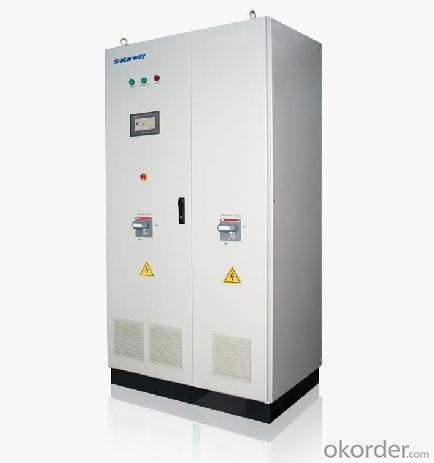
FAQ:Pls introduce more about CNBM
CNBM Group is short for China National Building Materials Group Corporation, which is established in 1984 with approval from the State Council
CNBM Group is the largest comprehensive building materials industry group in China
The Group has a total asset of over RMB 360 billion, more than 180,000 employees and 17 subsidiaries
- Q: How does a solar controller prevent damage from reverse current flow in the load?
- A solar controller prevents damage from reverse current flow in the load by incorporating a blocking diode or a solid-state relay in its design. These components ensure that current flows only from the solar panel to the load, preventing any backflow of current. This protective measure prevents the load from being damaged by reverse current and ensures the efficient operation of the solar system.
- Q: Can a solar controller be used in a solar-powered interplanetary travel system?
- Yes, a solar controller can be used in a solar-powered interplanetary travel system. A solar controller regulates the flow of electricity from the solar panels to the batteries, ensuring efficient charging and preventing overcharging. In an interplanetary travel system, where solar power is the primary source of energy, a solar controller would play a crucial role in managing and optimizing the power supply to the spacecraft's systems.
- Q: Can a solar controller be used with PWM (Pulse Width Modulation) technology?
- Yes, a solar controller can be used with PWM (Pulse Width Modulation) technology. PWM technology is commonly used in solar charge controllers to regulate the charging of batteries by varying the width of the charging pulses. This helps to maintain a steady and efficient charging process, extending the lifespan of the batteries.
- Q: How long do solar controllers typically last?
- Solar controllers typically last between 5 to 15 years, depending on the quality of the controller and the environmental conditions it is subjected to.
- Q: Can a solar controller be used with a solar-powered water purification system?
- Yes, a solar controller can be used with a solar-powered water purification system. A solar controller is responsible for regulating the amount of power being generated by solar panels and ensuring that it is optimized for the system's needs. In a solar-powered water purification system, the solar controller would help manage the power supply to the purification components, such as pumps or filters, ensuring efficient operation and maximizing the use of solar energy.
- Q: Can a solar controller be used with different types of solar panel mounting systems?
- Various types of solar panel mounting systems can be used in conjunction with a solar controller. The solar controller's role is to regulate the flow of electricity from the solar panels to either the batteries or the grid. This regulation is not contingent upon the specific mounting system employed. The primary function of the solar controller is to oversee and manage the charging process, guaranteeing efficient battery charging while preventing any potential damage or overcharging. As long as the solar panels align with the solar controller's voltage and current ratings, it can be utilized with any solar panel mounting system, such as roof-mounted, ground-mounted, or tracking systems.
- Q: Can a solar controller handle power fluctuations from appliances?
- Yes, a solar controller can handle power fluctuations from appliances. Solar controllers are designed to regulate and stabilize the power output from solar panels to ensure a steady flow of energy to connected appliances. They have built-in protection mechanisms like voltage regulation, overcurrent protection, and temperature control, which allow them to handle fluctuations in power demand and supply effectively. Additionally, some advanced solar controllers also offer features like load control and power optimization to further manage and accommodate power fluctuations from appliances.
- Q: Can a solar controller be used with solar-powered indoor cooling systems?
- Yes, a solar controller can be used with solar-powered indoor cooling systems. A solar controller is a device that regulates the flow of electricity from the solar panels to the cooling system. It ensures that the solar panels are charging the batteries efficiently and prevents overcharging or discharging. Whether it is a solar-powered air conditioner, evaporative cooler, or any other cooling system, a solar controller helps optimize the utilization of solar energy and ensures the smooth operation of the system. By monitoring and controlling the power flow, a solar controller helps to increase the overall efficiency and reliability of solar-powered indoor cooling systems.
- Q: Can a solar controller be used in a solar-powered electric bike charging system?
- Yes, a solar controller can be used in a solar-powered electric bike charging system. A solar controller is designed to regulate the voltage and current from solar panels, ensuring that the battery is charged efficiently and safely. In a solar-powered electric bike charging system, the solar controller can be used to manage the charging process, protect the battery from overcharging, and optimize the energy transfer from the solar panels to the bike's battery.
- Q: Can a solar controller be used with AC-coupled solar systems?
- AC-coupled solar systems can indeed utilize a solar controller. These systems typically work alongside a battery storage system to maximize the efficiency and effectiveness of solar energy utilization. The solar controller, also referred to as a charge controller, plays a crucial role in these setups by managing the charging and discharging of the batteries. In an AC-coupled solar system, the solar panels generate DC power, which is then converted into AC power by an inverter. This AC power can either be used to power household appliances or be fed back into the grid. The solar controller takes charge of overseeing the battery charging process, utilizing the DC power produced by the solar panels. The solar controller's main responsibility is to monitor the battery voltage and ensure it remains within safe limits. It accomplishes this by regulating the flow of current, preventing overcharging and overheating of the batteries. Additionally, the solar controller safeguards the batteries from damage caused by deep discharge. While the inverter is primarily responsible for grid integration and power management in AC-coupled solar systems, the presence of a solar controller remains crucial for the efficient operation of the battery storage system. It guarantees that the batteries are optimally charged and their lifespan is extended. In conclusion, it is both possible and advisable to incorporate a solar controller into AC-coupled solar systems. This will effectively regulate the charging and discharging of batteries, ensuring their optimal performance and longevity.
Send your message to us
PV Off-Grid Inverter GN-10/20/30/40/50KF Switch Box for Solar Controllers from CNBM
- Loading Port:
- China Main Port
- Payment Terms:
- TT or LC
- Min Order Qty:
- -
- Supply Capability:
- -
OKorder Service Pledge
OKorder Financial Service
Similar products
Hot products
Hot Searches
Related keywords
